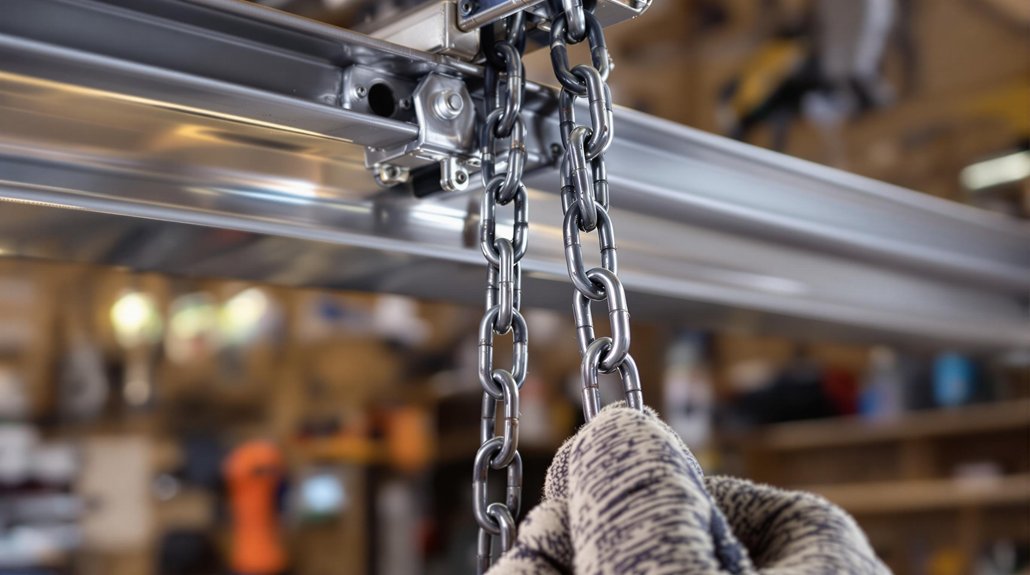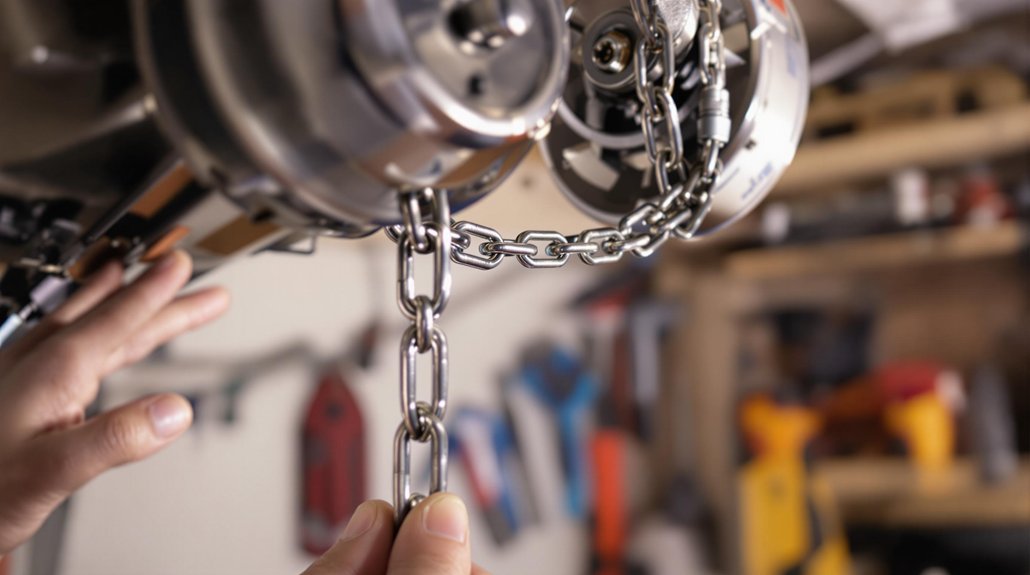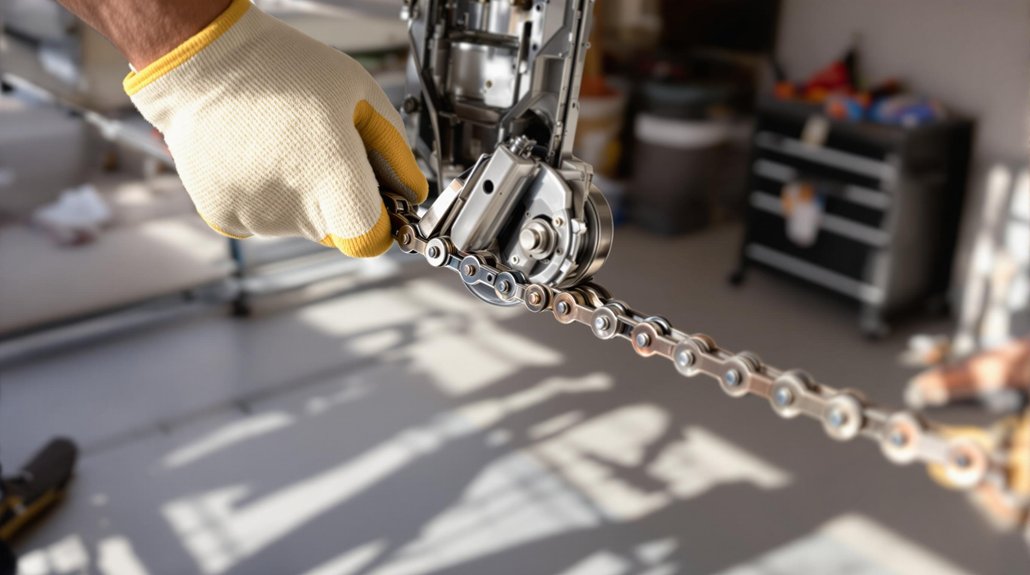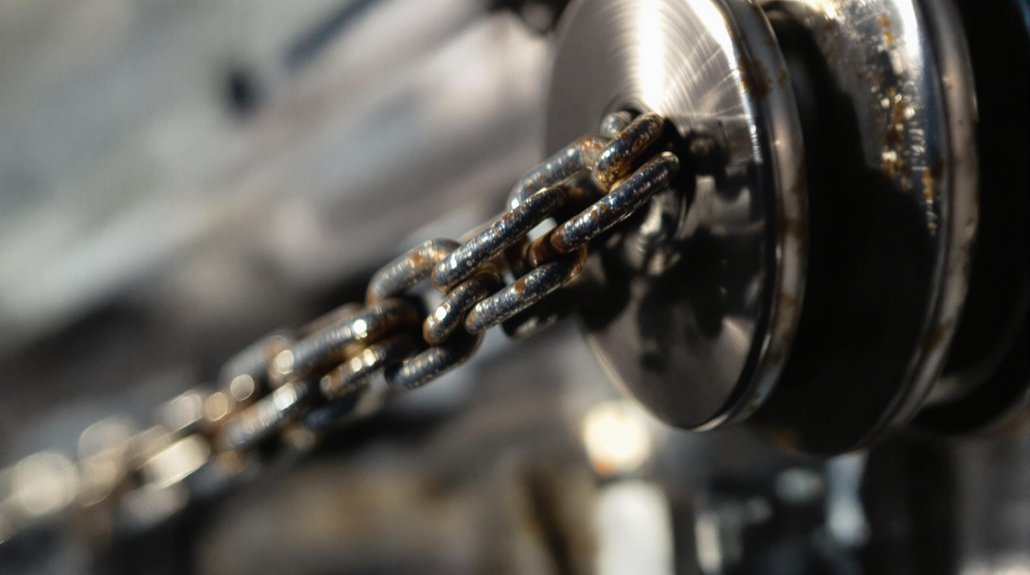A garage door chain should be tight, but not excessively so. Proper tension is essential for safe and efficient operation. If the chain is too loose, it can slip, leading to potential malfunctions. Conversely, a chain that is too tight may strain the system. Regular checks for tension can help avoid issues like uneven door movement or strange noises. It is best to allow slight upward movement of about half an inch. Ensuring proper chain tightness contributes to the overall longevity of your garage door system and reduces risks. More information on maintenance techniques is available for better understanding.
Key Article Highlights
- A garage door chain should be tight enough to prevent excessive slack, which can lead to operational issues.
- Ideal tightness allows slight upward movement of about half an inch; too loose leads to slippage.
- Overly tight chains can cause strain on the mechanism and may result in rattling noises.
- Regular maintenance is essential; check chain tension monthly and adjust as needed to ensure safety.
- Use proper tools for adjustments to avoid accidents and follow manufacturer guidelines for best results.
Importance of Chain Tension
Chain tension is a critical aspect of garage door operation. Proper tension helps guarantee that the door opens and closes smoothly. When the chain is appropriately tensioned, it reduces the risk of chain wear. This wear can lead to malfunctioning doors and potentially costly repairs.
Tension benefits extend beyond just functionality. A well-tensioned chain contributes to the overall safety of the garage door system. It prevents the chain from slipping or derailing, which can pose hazards to users and property. Additionally, maintaining the correct tension can enhance the longevity of the entire garage door mechanism.
Regularly checking and adjusting the chain tension is essential for peak performance. Over time, chains can loosen due to environmental factors or frequent use, leading to inefficiencies. By keeping the tension within the recommended range, homeowners can guarantee their garage door operates at peak performance.
Signs of Improper Tension
Improper tension in a garage door chain can lead to several noticeable issues. Look for excessive slack in the chain, which may indicate a problem. Additionally, unusual noises during operation and uneven door movement are clear signs that the chain tension needs to be checked.
Excessive Slack in Chain
A properly tensioned garage door chain is essential for ideal operation. Excessive slack in the chain can lead to various issues that affect the overall performance of the garage door system. When the chain is too loose, it may create problems such as misalignment and inefficient movement. This results in a greater risk of chain wear, which can shorten the lifespan of the components involved.
Another concern with excessive slack is that it can hinder proper chain lubrication. Adequate lubrication is necessary for smooth operation, and a loose chain may not allow for even distribution. This can lead to increased friction and further wear on the chain and other parts of the garage door system.
To identify excessive slack, check the chain's tension regularly. If you can lift the chain more than a few inches away from the track, it likely needs adjustment. Maintaining the correct tension not only guarantees smooth operation but also prolongs the life of the garage door components. Addressing excessive slack promptly can save time and money on repairs while enhancing the overall functionality of your garage door system.
Unusual Noises During Operation
Unusual noises during the operation of a garage door can signal issues related to chain tension. When the chain is either too loose or too tight, it can create various sounds that indicate a need for adjustment. These chain noises can be a sign of lubrication issues or other problems that require attention.
Here are four common unusual noises to listen for:
- Grinding Sounds: This may indicate insufficient lubrication on the chain or sprockets. Regular lubrication can prevent this noise.
- Banging Noises: A loose chain can lead to banging against the guide rails. Tightening the chain can help eliminate this noise.
- Squeaking: This is often a result of friction due to lack of lubrication. Applying the correct lubricant can resolve this issue.
- Rattling: A chain that is too tight can cause rattling during operation. Proper tension adjustment is necessary to fix this.
Being aware of these sounds can help you maintain your garage door effectively. Addressing chain noise early can prevent more serious issues down the line, ensuring smooth operation and longevity of your garage door system.
Uneven Door Movement
Noises during operation can often hint at deeper issues with a garage door system, including uneven door movement. This problem can arise from various chain issues within the garage door mechanism. When the chain is either too loose or too tight, it can cause the door to move unevenly, leading to potential safety hazards and further damage.
You may notice that one side of the garage door rises or falls more quickly than the other. This imbalance can create stress on the door and the opener, decreasing the system's lifespan. Additionally, if the door hesitates or seems to jerk during operation, it often indicates a problem with the chain's tension.
Regular maintenance is essential to guarantee that your garage door functions smoothly. Inspect the chain for signs of wear or improper tension and adjust it as needed. If you are unsure about making these adjustments yourself, consider hiring a professional. Addressing uneven door movement promptly will help maintain the efficiency of your garage door system and prevent costly repairs in the future. Understanding these signs is key to mastering garage door maintenance and guaranteeing its longevity.
How to Check Chain Tension

Ensuring proper chain tension is essential for the smooth operation of your garage door. Over time, chains can experience wear, affecting functionality. Regularly checking the tension will help maintain performance and prolong the lifespan of your garage door system. Here's how to check chain tension effectively:
- Gather Tension Tools: Collect the necessary tools, such as a wrench and a tension gauge, to assist in measuring the tension accurately.
- Inspect the Chain: Look for signs of chain wear, including rust or fraying. A worn chain may not perform properly, regardless of its tension.
- Check Tension: Use your hands to lift the chain slightly. There should be minimal slack. If the chain feels loose or moves excessively, it may need adjusting.
- Adjust if Necessary: If the tension is not ideal, refer to your garage door manual for instructions on how to tighten the chain using the appropriate tension tools.
Ideal Chain Tightness
Proper chain tightness is imperative for the efficient operation of a garage door system. The ideal chain tightness guarantees smooth movement and reduces wear on components. A chain that is too loose can lead to slippage, while a chain that is too tight may cause strain on the motor and other parts.
To determine the ideal tightness, consider the chain length. A well-adjusted chain should allow for a slight upward movement of about half an inch when lifted. This gives enough slack for flexibility without compromising performance.
Using the right adjustment tools is essential for achieving the proper tension. Tools such as wrenches and screwdrivers can help adjust the tensioner, allowing you to either tighten or loosen the chain as needed. Regular checks on chain tightness can prevent future issues, guaranteeing that the garage door operates smoothly and quietly.
Ultimately, maintaining the ideal chain tightness is a simple yet critical task that contributes to the longevity of your garage door system. By taking the time to check and adjust, you can avoid costly repairs and guarantee peak functionality.
Adjusting the Chain Tension

Regularly adjusting the chain tension is essential for the best performance of your garage door system. Proper chain tension helps prevent chain wear and guarantees smooth operation. Here are steps to adjust the chain tension effectively:
- Gather Adjustment Tools: You will need a wrench, screwdriver, and possibly a level. Confirm you have the right tools ready before starting.
- Check the Current Tension: Manually lift the door halfway and observe the chain. It should have a slight amount of slack but not be overly loose.
- Make Adjustments: Locate the tension adjustment mechanism on your garage door opener. Use the wrench to loosen the lock nuts, then adjust the chain tension by either tightening or loosening the chain.
- Test the Door: After adjustment, test the door's operation. It should move smoothly without any grinding noises. Recheck the tension after a few uses to confirm it remains ideal.
Common Mistakes to Avoid
Adjusting the chain tension can considerably impact the performance of your garage door system. However, there are common mistakes that can lead to unwanted issues. One mistake is neglecting regular maintenance. Over time, chain wear can occur, which affects the door's operation. Regularly inspecting the chain for signs of wear helps maintain peak function.
Another common error is using improper tension tools. Using the wrong tools can make it difficult to achieve the right tension. Always select the appropriate tools designed for garage door systems to guarantee accuracy.
Additionally, many overlook the balance of the garage door. Focusing solely on chain tension without checking the door's balance can result in uneven wear and further complications. Always check both aspects for best results.
Lastly, rushing the adjustment process can lead to errors. Take your time to adjust the tension gradually, checking the door's responsiveness after each small adjustment. This careful approach will help you avoid major problems down the line. By avoiding these mistakes, you can guarantee your garage door operates smoothly and effectively.
Safety Considerations

Safety should always be a top priority when working on garage door systems. Proper chain safety is essential to avoid accidents and guarantee the system operates smoothly. One important aspect to reflect on is the tension of the garage door chain. Incorrect tension can lead to various risks. Here are four key safety considerations to keep in mind:
- Inspect Regularly: Check the chain for wear and tear. A damaged chain can snap, leading to severe injuries.
- Adjust Tension Carefully: If the chain is too loose or too tight, it can cause operational issues. Adjust it gradually to find the right balance.
- Use Proper Tools: Always use the correct tools when making adjustments. Improper tools can lead to accidents or damage to the system.
- Follow Manufacturer Guidelines: Refer to the garage door manufacturer's instructions for specific safety measures related to chain tension and maintenance.
Regular Maintenance Tips
Maintaining the proper tension of a garage door chain is essential for guaranteeing safe and efficient operation. Regular maintenance can prevent issues and prolong the lifespan of your garage door system. A well-planned maintenance schedule is key to achieving this goal.
Here are some essential maintenance tips:
| Task | Frequency | Notes |
|---|---|---|
| Inspect Chain Tension | Monthly | Adjust if necessary |
| Chain Lubrication | Every 3 months | Use a silicone-based lubricant |
| Check for Wear | Every 6 months | Look for frayed or damaged links |
| Clean Tracks | Quarterly | Remove debris and dirt |
| Test Door Operation | Monthly | Guarantee smooth opening/closing |
Incorporating these tasks into your maintenance schedule can help keep your garage door functioning smoothly. Pay special attention to chain lubrication as it reduces friction and wear. Regular inspections and timely adjustments will not only enhance safety but also improve the overall performance of your garage door system. By following these tips, you will guarantee your garage door remains in prime condition for years to come.
Frequently Asked Questions
Can a Loose Chain Affect Garage Door Security?
A loose chain can greatly affect garage door security. When the chain is not properly tensioned, it may lead to improper operation, increasing the risk of unauthorized access and compromising overall safety and functionality.
How Often Should I Check My Garage Door Chain?
Regularly checking your garage door chain is essential for peak performance. Aim to inspect it every month, implementing chain maintenance tips to guarantee functionality. This proactive approach enhances safety and prolongs the lifespan of your garage door system.
What Tools Do I Need for Chain Adjustment?
For effective chain adjustment during garage door maintenance, essential tools include a socket wrench, adjustable pliers, and chain tensioning tools. These instruments will facilitate proper alignment and guarantee peak operation of your garage door system.
Is It Safe to Adjust the Chain Myself?
Approximately 70% of homeowners engage in DIY maintenance. While adjusting the garage door chain can be safe, proper chain adjustment safety practices are essential. Always follow DIY maintenance tips and consult professionals if unsure about the process.
Can Weather Affect Chain Tension in Garage Doors?
Yes, weather can impact chain tension in garage doors. Changes in temperature and humidity may affect materials, requiring regular chain maintenance. Proper adjustments guarantee peak performance and longevity, safeguarding the door's functionality throughout varying weather conditions.
